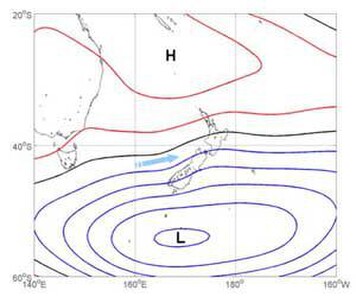There is a high probability of a cool spring and lower yielding vintage in Central Otago this year. The challenge will be to achieve good yields on the vines but there is no reason for the vintage not to be of outstanding quality.
Expect a colder than average spring, especially October to December, followed by a warmer than average January through April period. In total the heat summation is likely to be below average.
Already we are seeing a strong negative Southern Oscillation Index (SOI). (A negative SOI gives an indication of the development and intensity of El Niño in the Pacific Ocean). The last three months (May, June and July) have been the most negative SOI May-July period since 1997. 1997/98 was a very strong El Nino event.
The most challenging vintages for Grasshopper Rock have been when spring has been cool and unsettled. This includes the vintages of 2007, 2010 and 2015 when excellent wine was produced despite the challenges leading in to fruit set.
The corrseponding springs of 2006, 2009 and 2014, recorded the most negative spring SOI we have experienced in our time as winegrowers. The monthly average SOIs for the Sep-Dec periods in the respective years were -6.2, -6.1 and -7.8. Compare this to the -14.25 average SOI for the 1997 Sep-Dec period of the strong 1997/98 El Nino. It is too early to know what will be recorded in the coming Sep-Dec 2015 period but there is a high probability it will be a negative SOI.
With strong El Nino patterns anticyclones tend to pass west to east over the country further to the North than during La Nino. The NIWA map below shows the pattern and highlights the cooler west to southwest weather to be expected in Central Otago. (source: https://www.niwa.co.nz/our-science/climate/informa…)
This means cooler winds and a risk of wetter weather. The Southern Alps and its rain shadow effect means not all parts of Central Otago are wetter. The further east may be drier than normal but it could be wetter in the west. East coast regions such as Hawkes Bay and Marlborough can expect to be dry and good for growing grapes provided the vines have enough moisture and the spring is not too cold.

This winter we have already experienced more cool winds from the south than is normal and in mid-July some of the coolest temperatures on record. Winter of 2006 was the last time we experienced temperatures in Otago as cool as winter 2015. Then the resulting 2007 vintage proved a very low yielding year at Grasshopper Rock and one often described as the vintage from hell.
The current El Nino pattern may not hold but the lunar standstill around October 2015 would support the weather pattern continuing. To explain the lunar standstill it is best to read Wikipedia but it is a very predictable cycle and shows El Nino is a much an atmospheric event as an oceanic event.
Quote from Wikipedia: “The following table shows some occasions of a lunar standstill. The times given are for when the moon’s node passed the equinox—the moon’s greatest declination occurs within a few months of these times, depending on its detailed orbit. However, the phenomenon is observable for a year or so on either side of these dates”. https://en.wikipedia.org/wiki/Lunar_standstill
Times of luna standstill
| major standstill | minor standstill |
| May 1988 | February 1997 |
| June 2006 | October 2015 |
| April 2025 | March 2034 |
I remember each of these years well. 1987/88 was a spring drought in Canterbury, especially North Otago when I worked there for The Rural Bank. 1997/98 is known as the Otago drought and probably cost the economy $600M http://www.teara.govt.nz/en/water-resources/page-1. 2006 was the spring of our second vintage and the coldest and most difficult vintage at Grasshopper Rock. All of these events are typical of El Nino weather patterns and each occurred around a major or minor standstill. Each minor (or major) standstill is 18.6 years apart and 9.3 years between each minor and major standstill.
If we see a very strong El Nino pattern, as we did in 1997/98, 2016 could be a good but challenging vintage for many. By the end of December 2015 we will know how the season is unfolding.
Below are quotes sourced from company websites from the 1998 vintage season.
This from a Babich 1998 vintage report: Perhaps the 1998 vintage is best summarised by a comment made by Joe Babich, Managing Director, “this is the best vintage I have ever seen in New Zealand, and I have been involved in well over 30 vintages”.
Raymond Chan had this to say in 2013: The 1998 vintage in New Zealand was one of the hottest and driest on record, and was regarded as one of the most unusual due to the extreme growing conditions. From the start, there were fans for the wines, who were amazed by the ripeness and structure of the grapes and wines that were produced.
Website comments from those growing grapes in Central Otago for the 1998 vintage include:
Felton Road: 1998 was warmer than 1997 with low to moderate yields.
Two Paddocks (Gibbston): 1998 was an exceptional season. The season began with strong cool westerlies. As the wind abated in summer, there came an extremely intense El Niño influence which culminated in the driest, hottest 16 to 18 months on record
